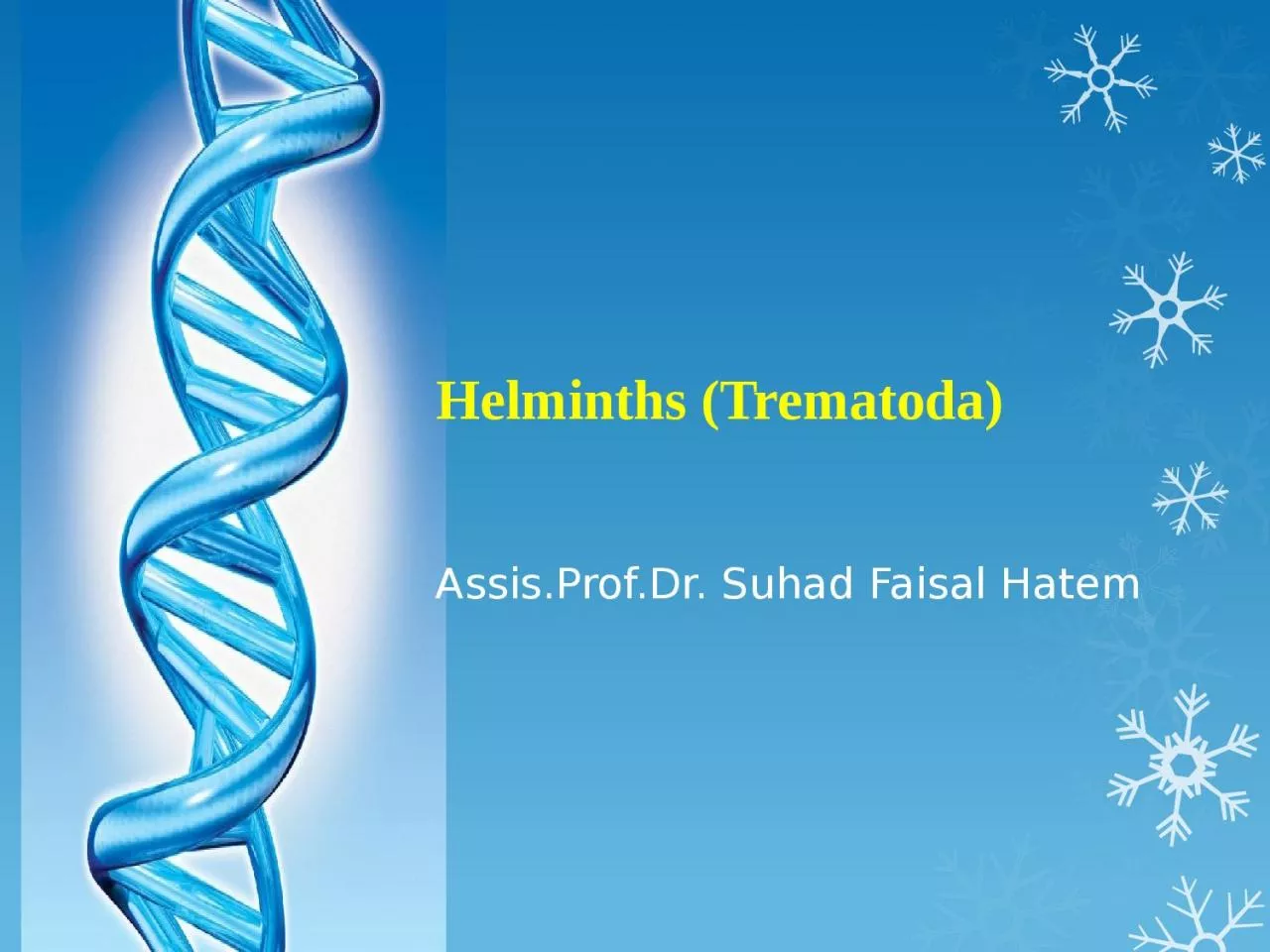

AssisProfDr Suhad Faisal Hatem Helminths Trematoda Helminth commonly known as parasitic worms are large multicellular organisms which when mature can generally be seen with the naked eye including ID: 930199
Download Presentation The PPT/PDF document "Helminths ( Trematoda )" is the property of its rightful owner. Permission is granted to download and print the materials on this web site for personal, non-commercial use only, and to display it on your personal computer provided you do not modify the materials and that you retain all copyright notices contained in the materials. By downloading content from our website, you accept the terms of this agreement.
Slide1
Helminths
(Trematoda)
Assis.Prof.Dr
. Suhad Faisal
Hatem
Slide2Helminths
(Trematoda)
Helminth
:
commonly known as
parasitic worms
, are large
multicellular
organisms, which when mature can generally be seen with the naked eye including
two-phyla
:
1. Phylum:
Platyhelminths
(flat worms)
2. Phylum:
Nemahelminths
or
Nematoda
(true round worms).
Platyhelminths
includes
:
1-Class:
Trematoda
)
Flukes
(
2-Class:
Cestoda
)
Tape worms
(
3
-
Turbellaria
Trematoda
class
also classified to groups according to the presence of the adult fluke in the host's body into:
1. Liver (or hepatic) flukes, ex:
Fasciola
hepatica
.
Clonorchis
sienensis
2. Intestinal flukes ex:
Fasciolopsis
buski
,
Heterophyes
heterophyes
3. Blood flukes, ex:
Schistosomes
4. Lung flukes, ex:
Paragonimus
westermani
Slide3Morphology and anatomy of
Fasciola hepatica Fasciola
hepatica
is one of the largest
flukes
of the world, reaching a length of 30 mm and a width of 13 mm,
Fasciola
gigantica
, on the other hand, is even bigger and can reach up to 75 mm
).
It is leaf-shaped, pointed at the back (
posteriorly
) and wide in the front (
anteriorly
). The
oral sucker
is small but powerful and is located at the end of a cone-shape projection at the anterior end
.
The
acetabulum
is a larger sucker than the oral sucker and is located at the anterior end
.
Adults of liver flukes are localized in the
liver
of various
mammals
, including
humans.These
flat worms
can occur in
bile ducts
,
gallbladder
, and
liver
parenchyma
. They feed on
blood
. Adult flukes produce eggs which are passed into the
intestine
. It depends on intermediate host (a snail) to complete its life cycle. The intermediate host is the
Lymnaea
genus of snail which lives in marshy areas and standing water
.
Fasciolosis
:
is a
parasitic worm
infection caused by the common liver fluke
Fasciola
hepatica
as well as by
Fasciola
gigantica
.
Slide4Slide5Slide6Pathogensis
Acute
fascioliasis
The acute clinical syndrome of
Fasciola
hepatica
infection occurs during migration of the fluke larvae to the liver parenchyma, with resultant inflammation and localized destruction of liver cells. Once in the bile ducts, liver flukes of all species produce inflammation due to mechanical irritation and toxic
secretions.
In its severe form it occurs in sheep but rarely in man and requires large numbers of parasites, usually over 10,000, to be ingested. Large numbers of migrating larvae invade the liver and cause a traumatic hepatitis that is frequently fatal. Sometimes the liver capsule may rupture into the peritoneal cavity, causing death from peritonitis
.
More usually the invasive phase lasts many weeks, with the most common symptoms being intermittent fever,
hepatomegaly
, and abdominal pain, malaise, wasting,
urticaria
and
eosinophilia
are usual.
Slide7Chronic
fascioliasis
This phase may develop months or years after initial infection, when the infection is asymptomatic.
Adult flukes in the bile ducts cause inflammation and hyperplasia of the epithelium. The resulting
cholangitis
and
cholecystitis
, combined with the large body of the flukes, are sufficient to cause mechanical obstruction of the
biliary
duct.This
lead to
biliary
colic
,
epigastric
pain, fatty food intolerance, nausea, jaundice,
pruritus
, right upper-quadrant abdominal tenderness.
Hepatic enlargement may be associated with an enlarged
spleen
or
ascites
Chronic inflammation is connected to increased cancer rates
.
Slide8Diagnosis
1- By finding yellow-brown eggs in the
stool.The
eggs pass through the body and out via the
faeces
.
2-An
enzyme-linked
immunosorbent
assay (ELISA) test
is the diagnostic test of choice. ELISA is available commercially and can detect anti-hepatica
antibodies
in serum and milk;
Proteases
secreted by
F. hepatica
have been used experimentally in immunizing antigen.
3- Radiological methods can detect lesions in both acute and chronic infection, while
laparotomy
will detect lesions and also occasionally eggs and live worms.
4-
biopsy
of liver, and gallbladder punctuate can also be used.
Treatment
1-Triclabendazole 2-protein-rich diet are recommended. Iron and vitamins may be required.
Slide9THANK YOU